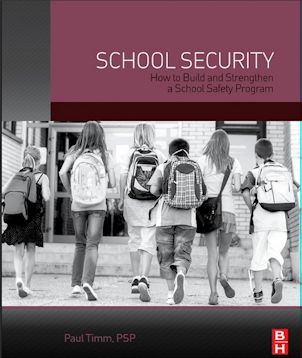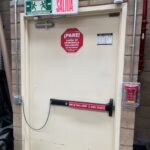 Paul Timm of RETA Security is a nationally-recognized expert on school security; you may have seen him in media reports on school security, or presenting at a school safety conference. RETA Security has been an acclaimed security consulting firm since 1984 when the company was founded by Ron Timm, and remains a family-owned firm that is not product-affiliated, focusing on the education market.
Paul Timm of RETA Security is a nationally-recognized expert on school security; you may have seen him in media reports on school security, or presenting at a school safety conference. RETA Security has been an acclaimed security consulting firm since 1984 when the company was founded by Ron Timm, and remains a family-owned firm that is not product-affiliated, focusing on the education market.
Paul recently published a book: School Security – How to Build and Strengthen a School Safety Program, and the book is now available in hard copy and as an ebook (you can order it here)! I admit, I skipped straight to the section of Paul’s book that talks about locking classroom doors, to see how it aligned with what we’ve been discussing. Paul has given me permission to post a portion of that section here:
“Schools that have some funding sometimes pursue an option that involves replacing locking mechanisms that lock from the outside with locking mechanisms that lock from the inside with a push button or a thumb turn. This replacement option aids in timeliness because it does not require a key to operate. This solution, however, presents an additional risk in that an unauthorized person can enter an unsecured room and lock out staff members. Schools that have an ample supply of funding are beginning to pursue options that permit all classroom doors to be locked electronically with the push of a button.
The best option, taking into account both budget and operations, involves replacing locking mechanisms that lock from the outside with locking mechanisms that lock from the inside with a key. In this scenario, teachers are required to keep that key on the staff ID lanyard so that it can be accessed and utilized as efficiently as possible.
The riskiest options employed today rely on relatively inexpensive aftermarket products that cover strike plates, prop open locked doors, or prevent ingress from the hallway. The products that cover strike plates, such as magnets or moveable plastic pieces, must be removed in order for the door to freely lock. The products that prop doors open must be kicked out of the way before the door can be secured. The products that prevent ingress from the hallway often require prior knowledge to utilize. Beware of these kinds of quick-fix solutions. These products can get jammed in the door frame or wedged underneath the door, and actually prevent doors from securing. They can be used by adversaries to keep authorized individuals from entering. They may violate fire egress codes or ADA codes. Consult fire marshals and door hardware manufacturers to review legitimate solutions.”
There are MANY locks available which provide safety AND security. Why compromise? Some days I feel like we’re fighting a losing battle to keep kids and teachers SAFE in addition to keeping them SECURE, but we just have to keep sharing this information and educating people. Let’s not wait for the next tragedy caused by improperly secured doors.
Who are YOU going to share this with?
You need to login or register to bookmark/favorite this content.





Leave A Comment